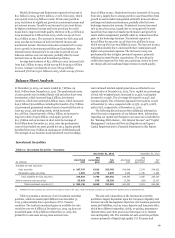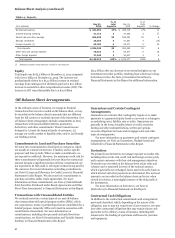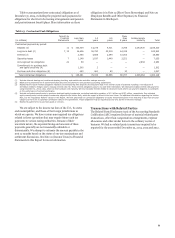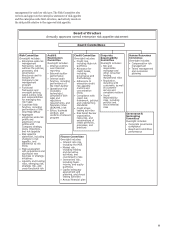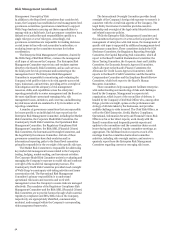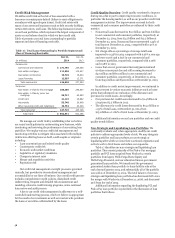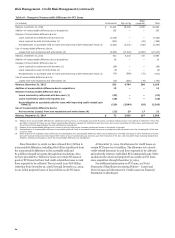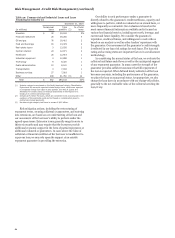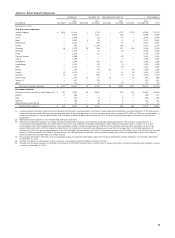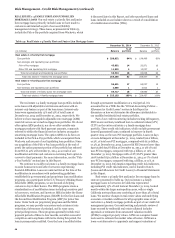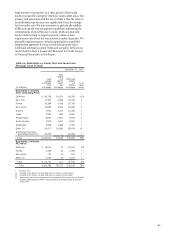Wells Fargo 2014 Annual Report Download - page 60
Download and view the complete annual report
Please find page 60 of the 2014 Wells Fargo annual report below. You can navigate through the pages in the report by either clicking on the pages listed below, or by using the keyword search tool below to find specific information within the annual report.
Credit Risk Management
We define credit risk as the risk of loss associated with a
borrower or counterparty default (failure to meet obligations in
accordance with agreed upon terms). Credit risk exists with
many of our assets and exposures such as debt security holdings,
certain derivatives, and loans. The following discussion focuses
on our loan portfolios, which represent the largest component of
assets on our balance sheet for which we have credit risk.
Table 16 presents our total loans outstanding by portfolio
segment and class of financing receivable.
Table 16: Total Loans Outstanding by Portfolio Segment and
Class of Financing Receivable
Dec 31, Dec 31,
(in millions) 2014 2013
Commercial:
Commercial and industrial $ 271,795 235,358
Real estate mortgage 111,996 112,427
Real estate construction 18,728 16,934
Lease financing 12,307 12,371
Total commercial 414,826 377,090
Consumer:
Real estate 1-4 family first mortgage 265,386 258,507
Real estate 1-4 family junior lien
mortgage 59,717 65,950
Credit card 31,119 26,882
Automobile 55,740 50,808
Other revolving credit and installment 35,763 43,049
Total consumer 447,725 445,196
Total loans $ 862,551 822,286
We manage our credit risk by establishing what we believe
are sound credit policies for underwriting new business, while
monitoring and reviewing the performance of our existing loan
portfolios. We employ various credit risk management and
monitoring activities to mitigate risks associated with multiple
risk factors affecting loans we hold, could acquire or originate
including:
• Loan concentrations and related credit quality
• Counterparty credit risk
• Economic and market conditions
• Legislative or regulatory mandates
• Changes in interest rates
• Merger and acquisition activities
• Reputation risk
Our credit risk management oversight process is governed
centrally, but provides for decentralized management and
accountability by our lines of business. Our overall credit process
includes comprehensive credit policies, disciplined credit
underwriting, frequent and detailed risk measurement and
modeling, extensive credit training programs, and a continual
loan review and audit process.
A key to our credit risk management is adherence to a well-
controlled underwriting process, which we believe is appropriate
for the needs of our customers as well as investors who purchase
the loans or securities collateralized by the loans.
Credit Quality Overview Credit quality continued to improve
during 2014 due in part to improving economic conditions, in
particular the housing market, as well as our proactive credit risk
management activities. The improvement occurred for both
commercial and consumer portfolios as evidenced by their credit
metrics:
• Nonaccrual loans decreased to $2.2 billion and $10.6 billion
in our commercial and consumer portfolios, respectively, at
December 31, 2014, from $3.5 billion and $12.2 billion at
December 31, 2013. Nonaccrual loans represented 1.49% of
total loans at December 31, 2014, compared with 1.91% at
December 31, 2013.
• Net charge-offs as a percentage of average total loans
improved to 0.35% in 2014 compared with 0.56% a year ago
and were 0.01% and 0.65% in our commercial and
consumer portfolios, respectively, compared with 0.06%
and 0.98% in 2013.
• Loans that are not government insured/guaranteed and
90 days or more past due and still accruing decreased to
$47 million and $873 million in our commercial and
consumer portfolios, respectively, at December 31, 2014,
from $143 million and $902 million at December 31, 2013.
In addition to credit metric improvements, we continued to
see improvement in various economic indicators such as home
prices that influenced our evaluation of the allowance and
provision for credit losses. Accordingly:
• Our provision for credit losses decreased to $1.4 billion in
2014 from $2.3 billion in 2013.
• The allowance for credit losses decreased to $13.2 billion or
1.53% of total loans, at December 31, 2014 from
$15.0 billion or 1.82% of total loans, at December 31, 2013.
Additional information on our loan portfolios and our credit
quality trends follows.
Non-Strategic and Liquidating Loan Portfolios We
continually evaluate and, when appropriate, modify our credit
policies to address appropriate levels of risk. We may designate
certain portfolios and loan products as non-strategic or
liquidating after which we cease their continued origination and
actively work to limit losses and reduce our exposures.
Table 17 identifies our non-strategic and liquidating loan
portfolios. They consist primarily of the Pick-a-Pay mortgage
portfolio and PCI loans acquired from Wachovia, certain
portfolios from legacy Wells Fargo Home Equity and
Wells Fargo Financial, and our education finance government
guaranteed loan portfolio. We transferred the government
guaranteed student loan portfolio to loans held for sale at the
end of second quarter 2014, and substantially all of the portfolio
was sold as of December 31, 2014. The total balance of our non-
strategic and liquidating loan portfolios has decreased 68% since
the merger with Wachovia at December 31, 2008, and decreased
25% from the end of 2013.
Additional information regarding the liquidating PCI and
Pick-a-Pay loan portfolios is provided in the discussion of loan
portfolios that follows.
58



